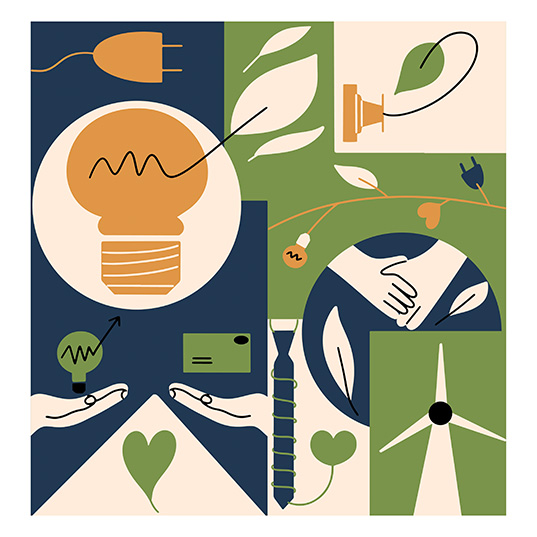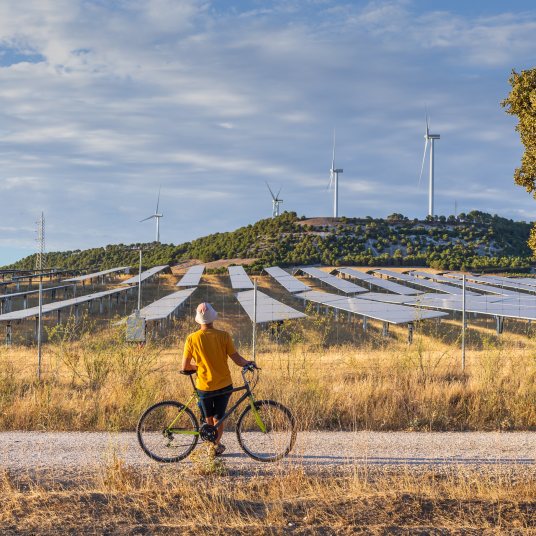Renewables are increasingly at the center of energy generation and the subject of new records. They reached an historic milestone in the European Union (EU) with wind and solar power surpassing fossil fuels as the main sources of electricity generation – an objective achieved by Spain back in 2013.
This year, Spain has seen renewable generation in its mainland market pass 50% for the first time –averaging 58.66% a month. In the summer months, photovoltaic generation even managed to overtake wind power, unheard of before in Spain.
These achievements are an important step toward a more sustainable economy and significant reduction in greenhouse effect gases. But there’s still a lot more to do.
What will I learn from this article?
Renewable energy has overtaken fossil fuels for the first time in Europe
According to a report published by clean energy experts Ember, the combined capacity of wind and solar energy has overtaken fossil fuel electricity generation capacity in the region for the first time.
Nearly one-third of EU electricity in May this year was generated from wind and solar power (31%, 59 TWh), while fossil fuels generated a record low of 27% (53 TWh). According to the Ember report, from January to May generation from coal and gas fell by 20% and 15% respectively compared to the same period in 2022.
“Nearly one-third of EU electricity in May this year was generated from wind and solar power”
Solar energy alone produced 14% of EU electricity during the month – the most ever. Even before the arrival of the summer sun, solar imposed itself for the first time on coal, which in May was only responsible for a tenth of the total.
 Add to this electricity generation from wind power (17%), which also grew compared to the year before, without reaching its January 2022 record of 23% of the bloc’s electricity.
Add to this electricity generation from wind power (17%), which also grew compared to the year before, without reaching its January 2022 record of 23% of the bloc’s electricity.
Spain’s performance stands out within the bloc. 2023 data up to September shows that half the energy produced in the country was renewable. The national electricity grid operator, Red Eléctrica, said electricity produced from wind was the year’s top generation source, accounting for 22.4% of the total between 1 January and 6 September this year.
For its part, solar photovoltaic was up 32.3% on the same period the year before. It is now the fourth biggest electricity producer by technology with 15.1% of the total.
This photovoltaic record was due to favorable weather conditions and installed capacity, since the technology has increased its share of the generation park as the third biggest source by installed capacity with 22,454 Megawatts (MW).
The growing influence of solar and wind power
According to latest information from the International Energy Agency, renewable energy capacity is expected to increase by a third this year as growing political support, higher fossil fuel prices and energy security concerns speeding up roll-out.
Indeed, solar photovoltaic energy capacity, including both small and large distributed systems, represent two-thirds of this year’s planned increase in world renewable capacity.
“Solar and wind energy are leading the rapid expansion of the new global energy economy. This year the world is ready to add a record quantity of renewable energies to electricity grids, more than the total energy capacity of Germany and Spain together,” said IEA executive director Fatih Birol.
Growth is expected to continue in 2024, reaching 4,500 Gigawatts (GW) of total renewable electricity capacity worldwide, equivalent to the total energy production of China and United States together, stated the IEA report, published in June.
“The global energy crisis has demonstrated that renewable energies are fundamental in ensuring that energy supplies are not only cleaner but also safer and more accessible,” said Birol.
Decarbonizing the energy sector by 2040 - to decarbonize the economy as a whole by 2050
 The numbers give reason to be optimistic, although there’s still a lot to do to achieve carbon neutrality by 2050. The IEA points out that, to do so, it will be necessary to decarbonize the energy sector a decade beforehand, by 2040.
The numbers give reason to be optimistic, although there’s still a lot to do to achieve carbon neutrality by 2050. The IEA points out that, to do so, it will be necessary to decarbonize the energy sector a decade beforehand, by 2040.
As the Spanish newspaper La Vanguardia reports, the scientific community is focusing on the short-term roll-out of wind and solar energy, the electrification of the use of energy, and promotion of fossil fuel alternatives, with green hydrogen as the catalyst.
It says a realistic plan, with carbon neutrality by 2050 as the goal, should entail the energy sector eliminating almost all fossil fuels by 2040.
Specifically, decarbonization of the EU electricity sector supposes gradual elimination of coal-based generation by 2030 and gas-based by 2040 (unless plants have CO2 capture and storage systems).
Renewable energies are already an indisputable part of the European energy make-up. This trend strengthens the EU’s commitment to the fight against climate change and serves as an inspiring example for other regions of the world looking to reduce their dependence on fossil fuels and embrace renewable energies.
Sources: